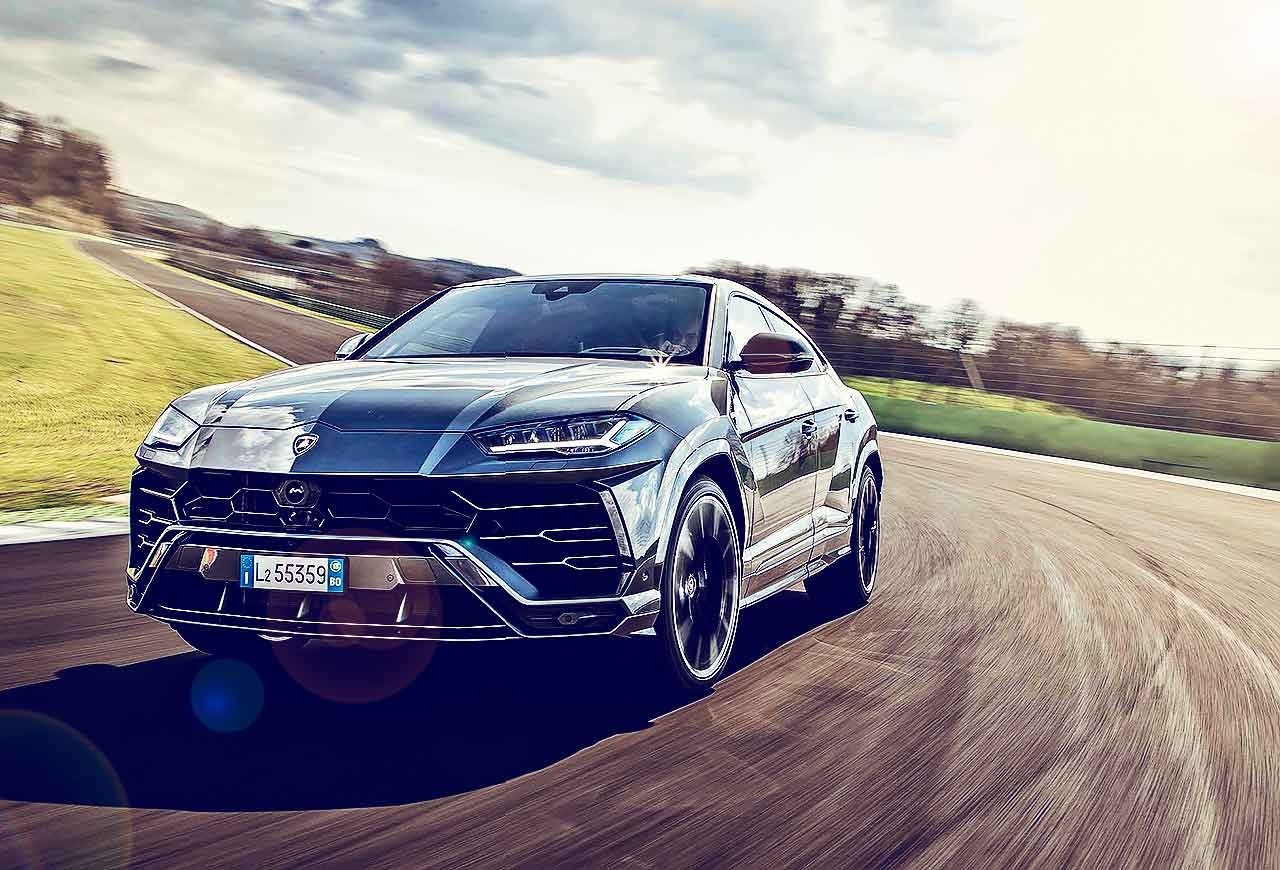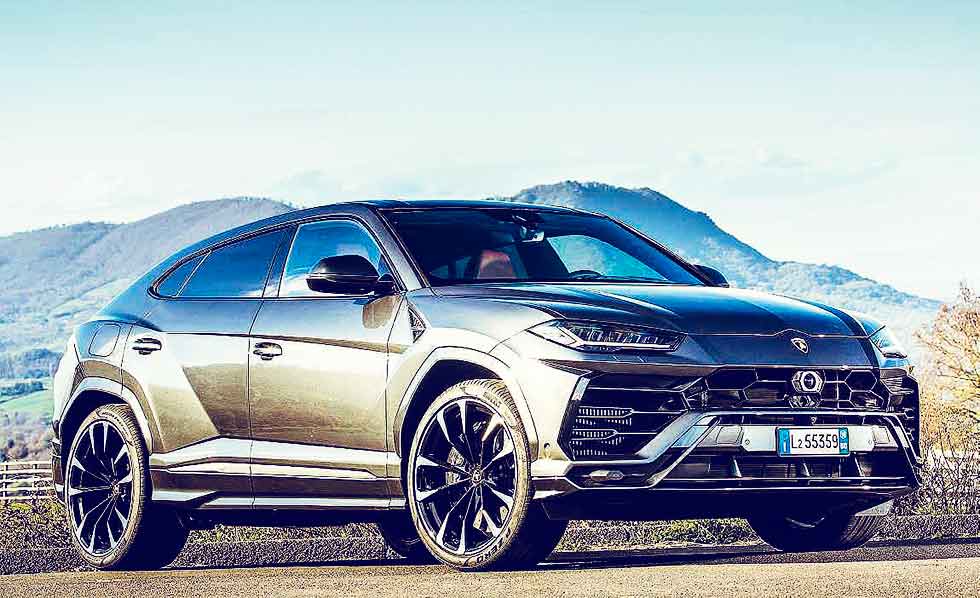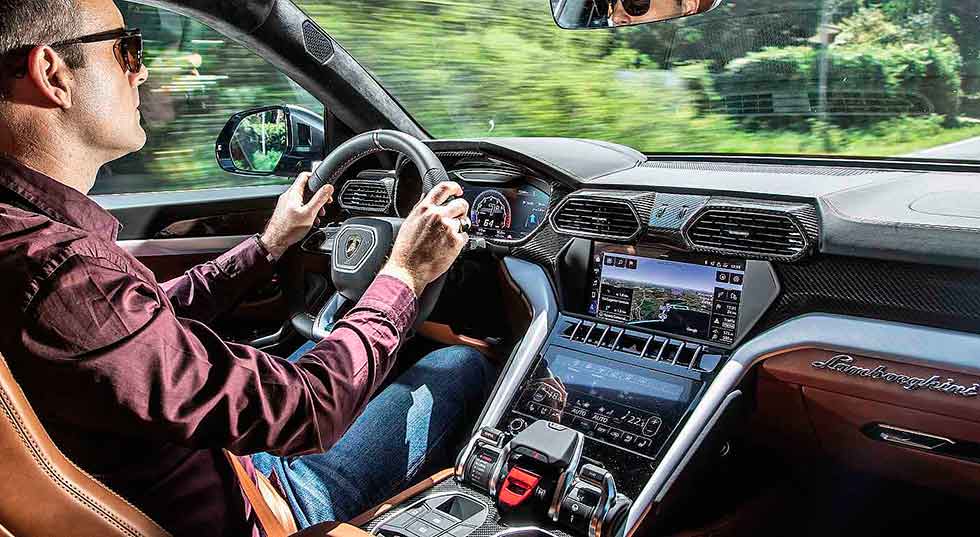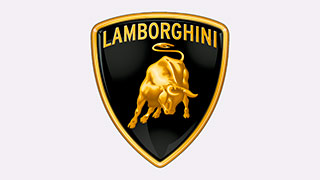
Bull Shift 2019 Lamborghini Urus There’s no V12 or V10 but there are four seats and the same number of doors, and the Urus is far from the cynical SUV you were expecting. From mid-engined supercars to this. Has Lamborghini pulled off the seemingly impossible by creating an SUV that doesn’t dilute everything the brand stands for? Text and photos by Adam Towler.
Lamborghini’s choice of hotel for the launch of the Urus is all marble-and-gold Italian luxury. A towering and formidable edifice of ’60s extravagance on the outskirts of Rome, its grandiose entrance, complete with de rigueur fountain, must have looked little different when it was newly constructed, complemented by some suave playboy pulling up to the concierge in his factory-fresh Miura. Transport yourself back to standing in the still heat of a Rome morning 50 years ago, and imagine suggesting to our Persol-adorned lothario that the same company which created the first, true manifestation of the supercar would one day create a vehicle like the Urus. What would Dallara, Bizzarrini and Gandini, young men burning midnight oil to realise an impossible dream, have made of this design brief?

Today, you can probe Maurizio Reggiani, Lambo’s charismatic engineering chief, over whether a modern-day Espada might have made a more authentic ‘practical’ Lamborghini, but he’s too polished at dealing with the media to comment outright, even if the twinkle in the eye and the expressive shrug of the shoulders suggests he’d be carving up that Panamera mule and putting an Aventador V12 on an engine crane faster than you can say Sant’Agata Bolognese.
Quite simply, if we are to talk sensibly about this car, we need to park the die-hard enthusiast hurt. I feel it. I know many of you do, too. But Lamborghini’s customers – both current and those waiting in the wings – have spoken. They had the choice of a four-door saloon, premiered by the Estoque concept in 2008, but they chose the SUV, and the reasons are straightforward. In a world that gives the impression of spiralling into conflict and social unrest, the high net worth individuals that form the Urus’s customer base want to feel safe. They want to look down on other road users, either for a literal sense of superiority, possibly, or more likely for that subconscious feeling of security that looking down on the world brings.
Many will be driven by women, with their children on board. They want useful luggage space, and five seats that are easy to ingress and egress. These are not my words – these are words direct from Lamborghini’s senior team; what its customers have told them they wanted, and exactly why.
So the challenge has been to take such a vehicle, complete with all the engineering compromises the SUV brings, and make it feel like a true Lamborghini. How do you do that? For Reggiani it’s about making it unequivocally the fastest SUV on the market, whether in a straight line, down a B-road, or around a circuit – asphalt or rough – while retaining all those practical attributes. Not a small job, then.

The other key reason Lamborghini can do this is because it is part of the VW Group, and that means, inevitably, platform sharing. A company that sells only 3500 cars a year can’t hope to develop something as advanced as a luxury SUV, and that’s also why you’re unlikely to see an SUV wearing a McLaren badge any time soon. Urus sales will double Sant’Agata’s production volume, which is why Lamborghini has invested in doubling the square footage of its factory and hiring 500 new staff. But it also removes a little of the mystique surrounding the Urus, for its raw constituent parts are nothing if not predictable.
It’s based on VW’s MLB-evo platform that underpins cars such as the Porsche Cayenne and Audi SQ7, and its engine’s roots are resolutely Teutonic. It’s the ubiquitous 4-litre twin-turbo V8, its twinscroll turbines located within the vee for improved response and a burgeoning torque curve that made it the only realistic choice for a vehicle such as the Urus.
Nevertheless, Lamborghini has gone its own way with the V8 to achieve the final numbers of 641bhp and 627lb ft, developing new cylinder heads, cooling systems, turbochargers, camshafts and so on. The V8 sends drive to the usual eight-speed torque-converter gearbox, but from there the Urus charts its own path. It soon becomes clear that to meet its objectives Lamborghini has had to pull all the toys out of the cupboard, from the four-wheel-steer set-up first employed on the Aventador S (and a regular on Porsches), to the active anti-roll bars (think Bentayga) and adaptive air suspension and variable damping.
Where it differs to say, a Cayenne, is in the drivetrain, because the Urus features a Torsen differential at the centre (not the Porsche’s ‘hang-on’ viscous clutch) with an active torque-vectoring diff on the rear axle. In numbers, this means the Torsen runs at 40:60, front:rear, in a steady state, but can send up to 70 per cent to the front axle and 87 per cent to the rear, while up to 75 per cent of torque can go to either rear wheel.
With so many electronically managed systems, the key, as usual, is integration. The driver can influence this via the Tamburo (that’s ‘drum’ in Italian), a cylindrical-shaped collection of levers and buttons at the base of the centre console. On the left is the ANIMA (Adaptive Network Intelligent Management) switch, offering the choice of Strada (road), Sport, Corsa (race) and Neve (snow), plus, optionally, Terra (gravel) and Sabbia (sand). To the right are the ‘Ego’ buttons for steering, powertrain (engine and ’box) and damping. Each of these has three settings – Smooth, Medium and Sport. You are either in one of the ANIMA modes, or mixing and matching yourself, not both. There are three ride-height levels, too.

At over 5 metres long, 2 metres wide and with a wheelbase of over 3 metres, the 2019 Urus is intimidatingly large. But it’s also obvious it sits lower than the traditional SUV (it’s wider, longer but lower than a Cayenne), an impression bolstered when you clamber aboard. Recalling the Aventador S from the 4WD mega-test in Drive-My, it seems impossible that the same company now also makes this, such is the ramp-up in quality and sophistication. The broad centre stack houses the latest flush-fit Audi-Porsche-style touchscreen, while extensive use of leather and an Alcantara headlining create the required luxury ambience. The driving position is most un-SUV-like in its sportiness, but a glance over the shoulder shows there’s plenty of legroom regardless of whether the three-seat bench or twin adjustable rear seats are fitted, although the sloping roofline means that for those over six feet tall (me), headroom is a little tight.
Right, enough of the practicalities: we drive the Urus at Vallelunga circuit first. Frustratingly, really, for it’s obviously of limited relevance, but Lamborghini is determined for us to experience what the car can do. Quite simply, it has created a monster. A freakish manipulator of physics which, while you’d never take it to a trackday, would embarrass many with its pace if you did. The initial overriding sensation is of acceleration: raw, unending forward thrust that grabs hold of 2.2 tons and forces it through the air with all the bovine strength the Urus name suggests. Gearchanges are crisp enough, and the brakes hold out – for a few laps of punishment, at least. Just how long those calipers and discs – ten-piston with 440mm carbon-ceramics at the front – can last before wilting remains to be seen, but the fact they aren’t juddering by the second lap is something of a miracle.
What you really notice is the agility, the crispness in how the Urus changes direction. Yes, it is a one-dimensional experience, an exercise in restraint and weight management – overcommit to a corner and the outside-front tyre makes that truck-racing whur-whur-whur noise – but it’s hugely impressive all the same.
Finally we’re let out onto the road, and the Urus feels inherently right. The steering is effortless but utterly accurate, and with nicely linear weighting. Switching to a sportier setting induces more rear-steer effect, vividly ramping up the sense of agility. It can’t hide the width of the car, though: on narrow lanes you’re acutely aware that the Urus is taking up an awful lot of space, just as it feels even more potent now than it did on the wide-open spaces of the track.

What disappoints is the ride quality. All the ‘road route’ cars on the launch are shod with the optional 23-inch rims and P Zeros (on track it was 22s with P Zero Corsas; for off-road it’ll be standard 21s with Pirelli Verde Scorpions). These giant alloys give the Urus a Tonka toy-like visual quality, but there’s a good chance the weight of the wheels and the meagre sidewalls contribute to the knobbly ride. The Urus’s overall deportment is relaxed, but it’s agitated by potholes. True, the roads around Vallelunga are unremittingly awful, but the air suspension struggles to isolate the cabin from the constant battering, too much noise and vibration making its way through. This is a pity, for the Urus has the core elements to be a fine everyday or long-distance companion. How the car rides on smaller wheels remains to be seen.
And off-road? We’re offered a drive on something resembling a rallycross track. It’s fun kicking up sand like a Dakar truck, but it doesn’t really tell us much.
Cards-on-the-table time. As someone passionate about old 911s, flimsy hot hatchbacks and cars in general that reward at real-world speeds and on real roads, I am immediately suspicious of the Urus. It is an engineering conjuring trick – the application of power and technology to answer a question that possibly need not have been asked. But, I admire it because relative to the brief, Lamborghini has done a very decent job.
Where Bentley has struggled with the Bentayga, which doesn’t ride as it should given its leaning towards luxury and comfort, and seems poorly packaged for space, Lamborghini has come much closer to nailing its objective, blending many different attributes under a Lambo-like skin. If the Urus does ride better on smaller wheels, it deserves to succeed. But given the first two years of production are already sold out, there no doubt that it already has.
Tech and photos
TECHNICAL DATA FILE SPECIFICATIONS 2019 Lamborghini Urus
Engine V8, 3996cc, twin-turbo
Max Power 641bhp @ 6000rpm / DIN net
Max Torque 627lb ft @ 2250-4500rpm / DIN net
Weight 2200kg (296bhp/ton)
0-62mph 3.6sec (claimed)
Top speed 190mph (claimed)
Basic price c£185,000
Drive-My rating 5.0
Above left: plenty of room in the rear. Left: Urus manages its 2.2 tons surprisingly well. Below left: optional 23-inch rims don’t help the ride quality. Above left: ‘Tamburo’ offers a myriad of driver settings. Left: Urus feels big on public roads. Below left: interior a step-up in quality and sophistication over other Lamborghinis’.
‘TO MEET ITS OBJECTIVES LAMBORGHINI HAS HAD TO PULL ALL OF ITS TOYS OUT ’
‘THE URUS IS A MONSTER – A FREAKISH MANIPULATOR OF PHYSICS’
BUT IS IT A LAMBO?
Chief engineer Maurizio Reggiani on realising the Urus
‘We wanted to have the fastest SUV. I think you will be impressed with the car on the track. You will also see the off-road course we have here at the launch. It is gravel. My interpretation is this – speed on gravel, not off-road like a Land Rover!
‘We can choose what we need from within the group – the technologies that enable us to realise the performance we need. The V8 engine was the only engine choice we could make, for example, because you need the torque available at very low rpm. However, while we work within the platform, if anyone [brands within the VW Group] wants something specific, such as we need with the cooling of the engine – oil, water and the gearbox – then we can take responsibility for this.

‘It’s the same with the engine: we have developed at Lamborghini a new intake manifold, cylinder head, camshafts, air filter, new twin-scroll turbos and the exhaust system. It is a Lamborghini engine. The sound is very important with a Lamborghini, but with a turbocharged engine you lose the sound, so we have a resonator in the exhaust to take the harmonics and sound into the cabin.
‘To develop the car we have taken on many more engineers. When I started at Lamborghini [in 1998] we had maybe 40, 50 engineers at the time of the Murciélago, whereas now we have hundreds – and this is to realise the Urus. We have tested the vehicle all over the world. Yes, we have tested it at the Nürburgring, where we have had a big development with the tyres: there are so many types of bumps, surfaces, corners and high-speed sections, it is so much easier there. I said during development that the Urus would set the fastest time, but yes, at the moment there is not so much competition in this class.’






